|
|
Addendum: This page was put up on
February 2007; it is now October. The first stage of this
congressional exercise in mendacity has sailed through, and comedian
Bill Maher made the following comment on his HBO show, "Real
Time":
"The people who are really getting tough with the Middle East
is the House Foreign Relations Committee... they voted yesterday to
condemn, as an act of genocide, the killings of Armenians, in Turkey,
in 1915. (Mild applause from clueless "do-gooders" in
the audience.) This is exactly why the voters gave control to
the Democrats: to send a stirring message to the Ottoman Empire."
(Huge laughter.)
What hope have the forces of truth when even a
smart fellow as Bill Maher, who prides himself on his skepticism, has
bought the Armenian genocide myth? (Or perhaps he was playing it safe,
so as not to bring Armenian wrath upon him and his show. But he
probably simply never investigated, beyond the easy surface, as most
all else. Revealing commentary from the panel discussion:
"Unbelievable," commented one of the three guests,
Tucker Carlson, MSNBC Anchor, as Maher continued: "To sell out
to the Armenian lobby, now there was a genocide in Armenia (Guest
Joy Behar of "The View" pipes in, "Yeah")
in 1915 , and it's a terrible thing, and I'm sure in a perfect world
we would... take time out to condemn this, but we are doing this at
the price of offending one of our key allies in the region,
Turkey..." Behar: "And wait till the Weimar Republic
hears about it." (Laughter)
Carlson: "What do we get out of it....What interest of ours is
served by making Turkey mad?" Paul Krugman of The New York
Times gives a sign that he does not know the answer. Maher: "Because
there are a lot of Armenians in, apparently this state
(California), and they're a lobby.it's the ultimate in special
interest lobbying." Behar: "The Armenians deserve
attention, but timing is everything; wait a little while."
Carlson: "I like the Armenians..." Maher, loudly, "We
all like the Armenians." Carlson: "This is all
pointless..." Maher, loudly, "We all like the
Armenians." (Hearty applause.)
|
We're going to put up the latest
resolution in its entirety, with brief examinations of each of its thirty
claims.
Even when politicians such as Pallone, Knollenberg, Schiff and Radanovich lie
prostrate before their Armenian benefactors, it's appalling that these
representatives — supposed to be guardians for truth, justice and "the
American way" (a reminder of what that partly entails: "Condemnation without hearing both sides
is unjust and un-American.") — could allow themselves to be such
complete stooges for Armenian propaganda. Do these men possess absolutely no
honor?
This particular resolution is remarkable for its totally shameless and
extremist propagandistic claims, filled with outright falsehoods; one would
think at this high level of operation, there would be at least some attempt to
tone down the outrageous content, in case a few of the congressional
representatives actually performed their duty, and made some attempt at
objective analysis. Even if these men are "bought" or are in fear of
the Armenians' great political power, how could they allow themselves to sink
to such a dishonest level? How do they look at themselves in their mirrors?
How can any real American justify re-electing such politicians bereft of
honor? If they are either so racist or incompetent as to not investigate all
sides of an issue or are so willing to sell out, how can they be expected not
to compromise other issues affecting their districts or nation?
One of our nation's greatest thinkers, Prof. John Dewey. warned Americans
against being deceived by Armenian propaganda, all the way back in 1928
("The Turkish Tragedy").
Indeed, the terrible reality is that most people of the West are too
brainwashed or prejudiced to consider this issue fairly. But when those placed
in positions of power to serve as our guardians against injustice allow
themselves to act so incompetently or dishonorably, the situation becomes
heartbreakingly contemptible.
Following the resolution and its rebuttal is an article
where the "Turkish Foreign Minister has the Ear of a Few
Congressmen"; next, we have a letter by a congressman,
defending his support of the resolution.
|
|
|
Parliaments
are elected to pass good laws; not to vote on historical facts about which the
majority of the deputies do not have the slightest idea. For almost ninety years there
is a debate about whether it was or was not a genocide, about the number of victims on
both the Armenian and Turkish side, whether the killings of the Armenian population
meet the criteria of the definition of the word "genocide", what ignited the
violence, and other important facts. Very few historians studied this matter, and
people often make up their mind about historical facts based on belief or prejudice. I
tried to read as much as possible of professional books on that matter and based on
the facts advanced by professors Bernard Lewis, Stanford Shaw, and Tadeusz
Swietochowski, and after reading arguments to the contrary — I came to the
conclusion that "armenian genocide " is a political, not historical concept.
Irena Lasota, president of the Institute for Democracy in Eastern Europe (IDEE), opining about the vote of the Polish
parliament on the "Armenian genocide."
|
Affirmation of the United States Record on the Armenian Genocide Resolution (Introduced
in House)
HRES 106 IH
110th CONGRESS
1st Session
H. RES. 106
Calling upon the President to ensure that the foreign policy of the United States reflects
appropriate understanding and sensitivity concerning issues related to human rights,
ethnic cleansing, and genocide documented in the United States record relating to the
Armenian Genocide , and for other purposes.
IN THE HOUSE OF REPRESENTATIVES
January 30, 2007
|

|
|
Adam Schiff[-ty]
|
Mr. SCHIFF (for himself, Mr.
RADANOVICH, Mr. PALLONE, Mr. KNOLLENBERG, Mr. SHERMAN, and Mr. MCCOTTER) submitted the
following resolution; which was referred to the Committee on Foreign Affairs
RESOLUTION
Calling upon the President to ensure that the foreign policy of the United States reflects
appropriate understanding and sensitivity concerning issues related to human rights,
ethnic cleansing, and genocide documented in the United States record relating to the
Armenian Genocide , and for other purposes.
Resolved,
SECTION 1. SHORT TITLE.
This resolution may be cited as the `Affirmation of the United States Record on the
Armenian Genocide Resolution'.
SEC. 2. FINDINGS.
The House of Representatives finds the following:
|
|
|

|
|
Thaddeus McCotter,
Michigan Republican,
like Joe Knollenberg
|
(1) The Armenian Genocide was conceived and
carried out by the Ottoman Empire from 1915 to 1923, resulting in the deportation of
nearly 2,000,000 Armenians, of whom 1,500,000 men, women, and children were killed,
500,000 survivors were expelled from their homes, and which succeeded in the
elimination of the over 2,500-year presence of Armenians in their historic homeland.
(1) Vahakn Dadrian (the “foremost authority on the
Armenian Genocide”) himself has written
that what is referred to as a genocide had “all but run its course” by 1916;
defeated in 1918, the Ottoman Empire ceased as an entity not long after. Therefore,
a practically nonexistent government could not have “carried out” a genocide
until 1923. The consensus of western
opinion of the period (e.g., the 1911 Encyclopedia Britannica) settled on 1.5
million as the total pre-war Ottoman-Armenian population, and even Dadrian vouches for 1 million survivors. At the end of 1918, Armenian leader Boghos Nubar
vouched for a resettlement of 600,000-700,000, not “nearly 2,000,000.” The
half-million (not “1,500,000”) mostly died (and were not “killed”) of famine
and disease, factors also claiming most of the 2.7 million other Ottomans who died.
Not a single Armenian was "expelled"; all resettled were allowed to return
by 1918's end, a good number had already returned earlier, and 644,900 Armenians (nearly half the original population) remained in what was left of the Ottoman Empire by 1921,
according to the Patriarch. Those who left on their own accord to lands outside
Ottoman control (e.g., Iran [50,000], Greece [120,000] and Transcaucasia [500,000, Hovannisian]) were free to return, as
stipulated by the Gumru and Lausanne Treaties.
(2) On May 24, 1915, the Allied Powers, England, France, and Russia, jointly issued
a statement explicitly charging for the first time ever another government of
committing `a crime against humanity'.
(2) The May
24, 1915 statement of the “Allied Powers, England, France, and Russia” rings
hollow when they had secret treaties
to divide the Ottoman Empire between themselves, and were overlooking Russia’s own
‘crime against humanity' against
Jews. The British treated their own non-rebellious German-British men with
greater relative severity
(given that the British were not bankrupt and resource-challenged, as the Ottoman
Sick Man, and not threatened with extinction), truly "deporting" (that is,
banishing outside national borders) their Germans and imprisoning the rest in what
amounted to "concentration camps." (By contrast, relocated
Ottoman-Armenians were mainly distributed among villages and not kept behind barbed
wire... but "fairly well satisfied... already
settled down to business and... earning their livings," as Morgenthau recorded
Representative Zenop Bezjian's message regarding Armenians at Zor.)
(3) This joint statement stated `the Allied Governments announce publicly to the
Sublime Porte that they will hold personally responsible for these crimes all
members of the Ottoman Government, as well as those of their agents who are
implicated in such massacres'.
(3) The Allies made good on their threat to hold Ottomans
“personally responsible” by conducting the Malta Tribunal (1919-1921), and holding up to 144 Ottomans
prisoner. No evidence could be found to "implicate" anyone, and every
accused was set free, aborting the need for trial.
(4) The post-World War I Turkish Government indicted the top leaders involved in the
`organization and execution' of the Armenian Genocide and in the `massacre and
destruction of the Armenians'.
(4) The “post-World War I Turkish Government” was a
puppet of the Allies. (There were one million
occupying British troops in the devastated nation, reduced to "only"
320,000 by 1919's end, according to Peter Balakian's "The Burning
Tigris.") Even the British held the findings of these kangaroo courts a
travesty of justice, and dismissed
them for their own Malta Tribunal.
(5) In a series of courts-martial, officials of the Young Turk Regime were tried and
convicted, as charged, for organizing and executing massacres against the Armenian
people.
(5) Officials found guilty were tried without due process
by a corrupt administration eager for retribution. As Dadrian tells us, they were pressured to find
guilty verdicts, otherwise terms of the peace conference would be severe.
|
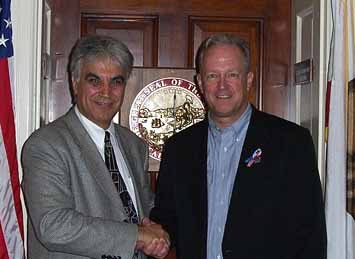
George Radanovich (R-CA; at right) poses with the
Armenian Technology Group's Executive Director; Radanovich was co-sponsor of 2003's
Armenian Genocide Resolution 193. Hye Sharzhoom interviewed the congressman on The Burning Tigris: “I read the Burning Tigris and thought it was so effective
in telling the story of the Armenian Genocide that I distributed copies, donated by
the Armenian National Committee of America, to every member of the House of
Representatives...I believe the book raises awareness of the Armenian Genocide, and
anything that raises awareness will help the effort to pass the resolution I
introduced on the Genocide.” How reassuring
that we have intellectuals like Radanovich in Congress, who determine complex issues
strictly by consulting one-sided works of
pure propaganda.
Radanovich raised eyebrows by trying to do away with a historic landmark in Yosemite
National Park, adhering to the facts again by complaining that the publicly-owned
history museum and library was for "private use." The Press criticized
his proposal in terms of "childish petulance unbecoming the dignity of a
congressman." |
(6) The chief organizers of the Armenian Genocide , Minister of War Enver, Minister of the
Interior Talaat, and Minister of the Navy Jemal were all condemned to death for their
crimes, however, the verdicts of the courts were not enforced.
(6) Enver, Talat and Jemal were indeed found guilty by this
illegal court, without producing factual evidence. Even a “genocide” champion of the
period, Johannes Lepsius,
vouched for Jemal’s protection of Armenians,
demonstrating the worth of these verdicts. (Jemal was off governing Palestine and Syria by
the time the relocation was first planned on May
2, 1915; he was not even around to serve as an "organizer" of the
"genocide.")
(7) The Armenian Genocide and these
domestic judicial failures are documented with overwhelming evidence in the national
archives of Austria, France, Germany, Great Britain, Russia, the United States, the
Vatican and many other countries, and this vast body of evidence attests to the same
facts, the same events, and the same consequences.
(7) There is no “overwhelming evidence” in the archives of
the countries mentioned; what there is an overwhelming amount of is “hearsay” and even
some forgeries. The British examined the best of Armenian-related documents in the U.S.
State Department, and rejected them
all as “personal opinions.”
(8) The United States National Archives and Record Administration holds extensive and
thorough documentation on the Armenian Genocide , especially in its holdings under Record
Group 59 of the United States Department of State, files 867.00 and 867.40, which are open
and widely available to the public and interested institutions.
(8) When perused, the “thorough documentation on the Armenian
Genocide” in the U.S. National Archives almost all derive from Armenian testimony, of
which an Associated Press correspondent had warned in 1895: "(Atrocity claims) must
be established independently of Armenian testimony, or their value may be seriously
questioned." Armenians told missionaries,
and missionaries told everyone else; Armenians also served near exclusively as
interpreters for the foreign consuls, including the Germans. Hearsay is never a substitute
for fact. If the records being referred to here in detestably "smokescreen"
fashion truly amounted to concrete evidence, not a single one of the countless Armenian
genocide web sites would have bypassed their reproduction. The bulk of these records
document one-sided suffering, and suffering is not genocide.
(9) The Honorable Henry Morgenthau, United States Ambassador to the Ottoman Empire from
1913 to 1916, organized and led protests by officials of many countries, among them the
allies of the Ottoman Empire, against the Armenian Genocide.
(9) Morgenthau’s private
diaries and letters proved how “dishonorable” he was, contradicting his claims
from the 1918 book ghost-written for propaganda purposes. During 1915, he was on friendly
terms with Ottoman officials, in contrast to his later “efforts
to make the Turks the worst being on earth” (as his critic, George Schreiner
worded it, December 11, 1918; see last link); Morgenthau was aware of the Armenians’
treason in his governmental communications (e.g., March 18, May 25, 1915), information he later
suppressed in order to present Armenians as innocent.
(10) Ambassador Morgenthau explicitly described to the United States Department of State
the policy of the Government of the Ottoman Empire as `a campaign of race extermination,'
and was instructed on July 16, 1915, by United States Secretary of State Robert Lansing
that the `Department approves your procedure . . . to stop Armenian persecution'.
(10) Morgenthau was heavily under the influence of Armenian assistants for his
information; he never ventured outside the capital’s environs in 1915 to see what was
happening (as opposed to newspaperman Schreiner, a genuine eyewitness who knew there was no “genocide”). Secretary of
State Robert Lansing later wrote (November 21, 1916, to Wilson) that the Armenians’ “disloyalty”
essentially made their relocation (i.e., "persecution") “justifiable.”
|
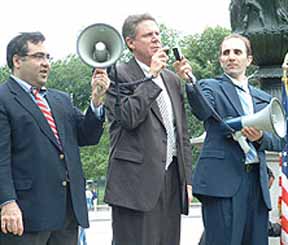
|
|
Frank Pallone, Jr., center,
at an ANCA event
|
Rep. Frank Pallone spoke at a 2005 ANCA-sponsored protest against the tragic events in Darfur. Does
anyone believe the Armenians of ANCA care about Darfur? Or was this ANCA's sneaky
and exploitative way to get their "Armenian genocide" message out
there? Here's what their man said: "It’s very reminiscent of what happened
in the case of the Armenian Genocide... There were people that were speaking out
that were not listened to. In the case of the Turks, they were out there in the
fields, constantly killing people and moving people into the desert. While there
were those who were speaking out [about the Armenian Genocide], the Western powers
really weren’t doing anything about it. We don’t want to be in that situation
again here in the United States.”
It was not just a handful "speaking out" against the Terrible Turk
during WWI, but everyone; in the case of the New York Times, for
example, to the tune of 145 articles in 1915 alone. And what did Pallone expect the
Western powers to do? Nobody could just walk in there and "fix" things, as
they had their hands full; there was a world war going on. (Pallone was actually a
history major as an undergraduate.)
|
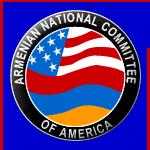
|
|
Don't
Quit till you make 'em
say ANCA!
|
Pallone also serves as Co-Chair of the
Congressional Sri Lankan- American Caucus and is the founder of the Congressional
Caucus for India. Who knows which other caucuses this polished politician elected to
serve on. What does serving on a caucus mean? It means the politician has an
obligation to favorably look upon the interests of the foreign nation he represents,
regardless of the issues. In short: "Politician for sale."
Pallone — which rhymes with "Baloney" — has been successfully elected
with a majority of the vote since 1988, because his state of New Jersey
traditionally goes with Democrats... and he supports some nice things, such as
conservation. (And some not-so-nice things, as the death penalty.) Yet isn't a
politician's eager willingness to marry himself with foreign interests a troublesome
aspect of integrity?
According to opensecrets.org, Pallone's "Ideological/Single Issue PAC
[Campaign] Contributions" more than doubled from 2002 ($13,825) to 2004
($40,985), inching up to $46,685 in 2006. More tellingly, his "Individual
contributions" (where identities need not be disclosed) doubled from 2002
($474,755) to 2004 ($985,717), and then nearly doubled again in 2006, at $1,689,201.
We'll never know how much these, and those from other categories (such as
"Business PACs") constituted Armenian money, but this slick has made sure
to cover his bases quite expertly... the truth be damned.
|
(11) Senate Concurrent Resolution 12 of February 9, 1916, resolved that `the
President of the United States be respectfully asked to designate a day on which the
citizens of this country may give expression to their sympathy by contributing funds
now being raised for the relief of the Armenians', who at the time were enduring
`starvation, disease, and untold suffering'.
(11) Then, as now, our Congress did not care for the ‘starvation,
disease, and untold suffering' of all Ottomans, just the politically powerful
Armenians. Note, by the way, the prominent reasons given for the Armenians' ills in
early 1916, when the "genocide" had "all but run its course": no
mention of massacres. "Starvation, disease and untold suffering"
aren't pretty, but have nothing to do with systematic extermination, particularly
when all other Ottomans were enduring the same tragedies. ("...All over Turkey thousands of the populace were daily dying
of starvation." Morgenthau.)
(12) President Woodrow Wilson concurred and also encouraged the formation of the
organization known as Near East Relief, chartered by an Act of Congress, which
contributed some $116,000,000 from 1915 to 1930 to aid Armenian Genocide survivors,
including 132,000 orphans who became foster children of the American people.
(12) The most successful charity drive in American history
resulted from massive Armenian propaganda, assisted by influential folks from all
walks of society (such as the Chairman
of the National Motion Picture Committee). Colonel William Haskell of the American Red Cross
thought with greater humanity: “America should feed the
half million Turks whose hinterland was willfully demolished by the retreating
Greeks, instead of aiding the Greeks and Armenians who are sitting around waiting
for America to give them their next meal. The stories of Turk atrocities circulated
among American churches are a mess of lies. I believe that the Greeks and not the
Turks are barbarians.” (Few Americans knew or cared about the worse crimes of the Armenians in the
east.)
(13) Senate Resolution 359, dated May 11, 1920, stated in part, `the testimony
adduced at the hearings conducted by the sub-committee of the Senate Committee on
Foreign Relations have clearly established the truth of the reported massacres and
other atrocities from which the Armenian people have suffered'.
(13) Our politicians, then and now, relied strictly on
deceptive Armenian propaganda without bothering to scratch the surface. An exception
was Senator James A. Reed, who declared, “The Armenian is
not guiltless of blood himself,” pointing out the wholesale massacres
committed by the Armenians, and criticizing General Harbord’s report as “a picture of the Armenians by the friend of the Armenians.”
(Congressional Record, 1920.)
(14) The resolution followed the April 13, 1920, report to the Senate of the
American Military Mission to Armenia led by General James Harbord, that stated `[m]utilation,
violation, torture, and death have left their haunting memories in a hundred
beautiful Armenian valleys, and the traveler in that region is seldom free from the
evidence of this most colossal crime of all the ages'.
(14) Yet even this great friend of the Armenians, General
Harbord, included in his report: “In the territory untouched
by war from which Armenians were deported the ruined villages are undoubtedly due to
Turkish deviltry, but where Armenians advanced and retired with the Russians their
retaliatory cruelties unquestionably rivaled the Turks in their inhumanity.”
(15) As displayed in the United States Holocaust Memorial Museum, Adolf Hitler, on
ordering his military commanders to attack Poland without provocation in 1939,
dismissed objections by saying `[w]ho, after all, speaks today of the annihilation
of the Armenians?' and thus set the stage for the Holocaust.
(15) Even an Armenian scholar, Dr. Robert John, summed up
this Hitler quote as a "forgery."
There were four versions of this Hitler speech, and the unsigned and undated one
containing this statement was rejected by the Nuremberg authorities, “embellished”
as it might have been (according to noted WWII historian William Shirer), and
containing other dubious references such as the obese Goring’s jumping on a table
and dancing wildly. The Holocaust Memorial Museum shamefully compromised its
credibility by exhibiting this falsehood, a bone thrown to the Armenians, perhaps in
appreciation for the big money donated by Armenians (such as the one million dollars
promised by Seth Moomjian).
|
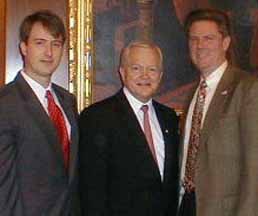
Armenian Assembly of America's Executive Director,
Bryan Ardouny, poses with Armenian Caucus Co-Chairs Joseph Knollenberg (R-MI) and
Frank Pallone, Jr., (D-NJ). Below, Armenian Assembly of America Chairman Richard
Mushegain presents Congressman Knollenberg with a book about Armenia.
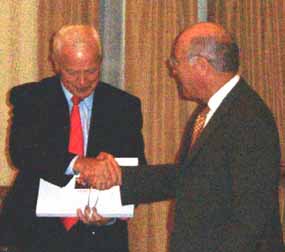
|
(16) Raphael Lemkin, who coined the term 'genocide' in 1944, and who was the
earliest proponent of the United Nations Convention on the Prevention and Punishment
of Genocide , invoked the Armenian case as a definitive example of genocide in the
20th century.
(16) Raphael Lemkin knew of the Armenians what he had read in the biased
western press, the hearsay of missionaries and Armenians. Lemkin’s prejudiced “personal
opinion” is no substitute for historical fact.
(17) The first resolution on genocide adopted by the United Nations at Lemkin's
urging, the December 11, 1946, United Nations General Assembly Resolution 96(1) and
the United Nations Convention on the Prevention and Punishment of Genocide itself
recognized the Armenian Genocide as the type of crime the United Nations intended to
prevent and punish by codifying existing standards.
(17) The United Nations has never “recognized the
Armenian Genocide as the type of crime” defined in its genocide convention. A 1985
subcommittee vigorously debated the issue, after having been made aware of the
actual facts, and refused to recognize it. (See "23" below.).
(18) In 1948, the United Nations War Crimes Commission invoked the Armenian Genocide
`precisely . . . one of the types of acts which the modern term `crimes against
humanity' is intended to cover' as a precedent for the Nuremberg tribunals.
(19) The Commission stated that `[t]he provisions of Article 230 of the Peace Treaty
of Sevres were obviously intended to cover, in conformity with the Allied note of
1915 . . ., offenses which had been committed on Turkish territory against persons
of Turkish citizenship, though of Armenian or Greek race. This article constitutes
therefore a precedent for Article 6c and 5c of the Nuremberg and Tokyo Charters, and
offers an example of one of the categories of `crimes against humanity' as
understood by these enactments'.
(18 & 19) If this commission came up with such
conclusions, its participants irresponsibly considered racist Armenian propaganda in
exclusivity. If their intention was to provide an example of “crimes against
humanity,” they totally ignored the systematic extermination campaign perpetrated
by Armenians against fellow Ottomans unlike the Armenians. These points have been
raised within this dishonest resolution as a deceptive subterfuge. The stillborn
Sèvres Treaty’s purpose was to declare a death sentence against the Turkish
nation, and to bring up an article from a criminal treaty marks the true “offense.”
(20) House Joint Resolution 148, adopted on April 8, 1975, resolved: `[t]hat April
24, 1975, is hereby designated as `National Day of Remembrance of Man's Inhumanity
to Man', and the President of the United States is authorized and requested to issue
a proclamation calling upon the people of the United States to observe such day as a
day of remembrance for all the victims of genocide , especially those of Armenian
ancestry . . .'.
(20) In order to label people as victims of genocide, one
must first prove a genocide had taken place. The simple fact is that there is no
evidence demonstrating a systematic, government-sponsored extermination plan against
Armenians; the actual evidence demonstrates the Ottoman government attempted to
safeguard Armenian lives and property, and its power and resources were insufficient
to curtail random violent acts committed by renegade forces. Prejudiced and ignorant
politicians in 1975 once again considered harmful propaganda in exclusivity, and
forgot to consider the universality of “Man's Inhumanity to Man”; if the victims
were, say, Muslim, they did not count.
|
The
deafening drumbeat of the propaganda, and the sheer lack of sophistication in argument
which comes from preaching decade after decade to a convinced and emotionally
committed audience, are the major handicaps of Armenian historiography of the diaspora
today.
Dr. Gwynne Dyer, 1976; in the last thirty years, that "convinced and emotionally
committed audience" has grown to include even more non-Armenians, proving once
again that the more a lie is repeated (especially on a near-exclusive basis), the more
people come to believe it. |
(21) President Ronald Reagan in proclamation number 4838, dated April 22, 1981, stated in
part `like the genocide of the Armenians before it, and the genocide of the Cambodians,
which followed it—and like too many other persecutions of too many other people—the
lessons of the Holocaust must never be forgotten'.
(21) The Armenians are a powerful and influential political force
in the United States, and are obsessed with their “genocide”; the extremists among
them sadly do not refrain from using falsehoods and other “end justifies the means”
tactics. Politicians, including presidents, sometimes forget their responsibility to serve
all of the people, and the truth. The fact that Ronald Reagan offered his “personal
opinion” that there was a genocide against Armenians is meaningless without the
historical evidence to back up such a claim.
(22) House Joint Resolution 247, adopted on September 10, 1984, resolved: `[t]hat April
24, 1985, is hereby designated as `National Day of Remembrance of Man's Inhumanity to
Man', and the President of the United States is authorized and requested to issue a
proclamation calling upon the people of the United States to observe such day as a day of
remembrance for all the victims of genocide, especially the one and one-half million
people of Armenian ancestry . . .'.
(22) It was a request the President refused. Hopefully he was
made aware that it would be impossible to kill “one and one-half million people” when
there were 1.5 million people to begin with, and even the worst Armenian propagandists of
current times agree 1 million survived. At the end of 1918, the Armenian Patriarch broke down his inflated pre-war population
figure of 2.1 million as such: 1,260,000 survivors, and 840,000
dead. The Armenians had initially settled on 600,000-800,000
dead at the postwar Peace Conference, and lobbied General Harbord with the figure of
600,000. Even Armenian propagandists of the period did not go as far as what the writers
of this resolution would have us believe.
(23) In August 1985, after extensive study and deliberation, the United Nations
SubCommission on Prevention of Discrimination and Protection of Minorities voted 14 to 1
to accept a report entitled `Study of the Question of the Prevention and Punishment of the
Crime of Genocide ,' which stated `[t]he Nazi aberration has unfortunately not been the
only case of genocide in the 20th century. Among other examples which can be cited as
qualifying are . . . the Ottoman massacre of Armenians in 1915-1916'.
(23) The claim of acceptance is an out-and-out falsehood. The
14-to-1 vote pertained to Resolution 1985/9 and not the "Study of Genocide"
Report (also known as the Whitaker Report, named after the rapporteur who prepared it).
The Sub-Commission refused to receive the
report, deleting the word "receives" from the draft resolution, merely
taking "note" of the study. It refused to praise the report by deleting words
such as "the quality of," and refused to transmit it to the Commission on Human
Rights. In order to clear the record in response to Armenian propagandistic claims, U.N. spokesman Farhan Haq stated on October 5th, 2000: "(The)
United Nations has not approved or endorsed a report labeling the Armenian experience as
Genocide."
(24) This report also explained that `[a]t least 1,000,000, and possibly well over half of
the Armenian population, are reliably estimated to have been killed or death marched by
independent authorities and eye-witnesses. This is corroborated by reports in United
States, German and British archives and of contemporary diplomats in the Ottoman Empire,
including those of its ally Germany.'.
(24) As even the Turk-disliking missionary, Cyrus Hamlin, wrote in 1893, regarding the tactics of the
Armenian terrorists who drove a wedge between Armenians and Turks: “Falsehood
is, of course, justifiable where murder and arson are.” The Dashnak terrorist
party is currently in control of the Armenian diaspora and Armenia. “Falsehood”
becomes justifiable, as in many of the claims of this resolution. In this example, they
totally misrepresent the status of this U.N. report (which was, after all, prepared by
only one biased individual), and rely on non-evidence as the “personal opinions” of
biased and/or ignorant diplomats who received their information entirely from missionaries
and Armenians. Once again, 1 million people could not have possibly died if there were 1
million survivors from a pre-war population of 1.5 million, and most died of famine and
disease, not from murder. Nearly the entirety of those “death-marched” reached their
destinations intact. The very bigoted U.S. Consul Jesse Jackson vouched for nearly half a million emigrees in 1916... "when
the genocide had all but run its course.”
(25) The United States Holocaust Memorial Council, an independent Federal agency,
unanimously resolved on April 30, 1981, that the United States Holocaust Memorial Museum
would include the Armenian Genocide in the Museum and has since done so.
(25) Relying on propaganda and not on fact damages the integrity of the Holocaust Memorial
Council; some involved perhaps irrationally fear a lessening of the Armenian story would
cast disbelief upon the Holocaust, stressing how politicized “genocides” have become.
Crafty Armenians were all too aware that hitching their genocide ride on the untouchable
Holocaust’s coattails would prove invaluable, and wealthy Armenians generously
supported, and continue to support, Holocaust centers.
|
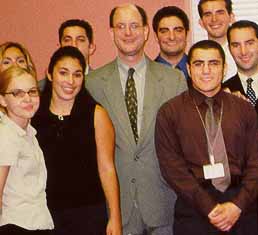 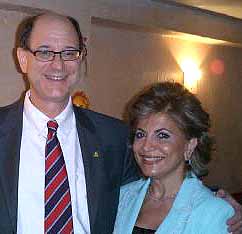
Congressman Brad Sherman (D-CA) with participants of
the Armenian Assembly's 24th Summer Internship Program, and at right, with arm around
Ms. Totah, an AAA Board of Trustees Executive. In 2002, as the AAA reported, Sherman
considered that U.S. support of a Baku-Tiblisi-Ceyhan pipeline was "almost an act
of hostility toward Armenia." (But all would be well as long as the pipeline went
through Armenia, you see.) Here's wondering why Sherman never shows outrage over
Armenia's actions in Nagorno Karabakh, which was unquestionably an act of hostility.
|
(26) Reviewing an aberrant 1982 expression (later retracted) by the United States
Department of State asserting that the facts of the Armenian Genocide may be
ambiguous, the United States Court of Appeals for the District of Columbia in 1993,
after a review of documents pertaining to the policy record of the United States,
noted that the assertion on ambiguity in the United States record about the Armenian
Genocide `contradicted longstanding United States policy and was eventually
retracted'.
(26) Once again a demonstration of the immense political power of
Armenian-Americans. If this “aberrant 1982 expression” served as a
contradiction, the Armenian genocide would have long ago been recognized through the
countless resolutions introduced along the years, as this one. While Armenians have
no monopoly on historical suffering, it is most telling that it is the Armenian
genocide bill that has kept recurring with jarring frequency. This is the kind of
power and intimidation the Armenian community utilizes on a regular basis, as in
2002 when pressured Feds commanded the U.S. Justice Department to drop Armenia from the watch-list of potential terrorist nations, freeing male Armenian nationals
from the INS fingerprinting and registration process.
(27) On June 5, 1996, the House of Representatives adopted an amendment to House
Bill 3540 (the Foreign Operations, Export Financing, and Related Programs
Appropriations Act, 1997) to reduce aid to Turkey by $3,000,000 (an estimate of its
payment of lobbying fees in the United States) until the Turkish Government
acknowledged the Armenian Genocide and took steps to honor the memory of its
victims.
(27)
This dishonest resolution is making barely any effort to focus on historical facts
(with good reason; to do so would cast doubt on the Armenians’ genocide
invention), and attempts to make its case by citing the “personal opinions” of
those swayed by propaganda, prejudice and ignorance... and money. Today, the
Congressional Caucus on Armenian Issues makes up more than one-third of the entire
House, a significant number when it comes to Armenians getting their way.
Congressmen Pallone and Knollenberg serve as Co-Chairmen of this Armenian Caucus,
and Schiff, Sherman and Radanovich likely feel beholden to the large numbers of
Armenians residing in their state of California.
Not incidentally, the "aid" to Turkey generally comes in the form of
monies that need to be paid back, and not free and clear cash, as given to Armenia,
the second greatest recipient of U.S. aid after Israel, per capita. The undemocratic
nation offers practically nothing of value to the USA, but they do spend millions in
pushing their propaganda and in influencing U.S. Congressmen... befitting their
reputation as "professional beggars," in the estimation of Col. Haskell
(see "pg. 212";
the Armenians sought revenge by engaging in their familiar smear tactics, charging
Haskell with stealing from the relief efforts... without offering proof, of course).
(28) President William Jefferson Clinton, on April 24, 1998, stated: `This year, as
in the past, we join with Armenian -Americans throughout the nation in commemorating
one of the saddest chapters in the history of this century, the deportations and
massacres of a million and a half Armenians in the Ottoman Empire in the years
1915-1923.'.
(29) President George W. Bush, on April 24, 2004, stated: `On this day, we pause in
remembrance of one of the most horrible tragedies of the 20th century, the
annihilation of as many as 1,500,000 Armenians through forced exile and murder at
the end of the Ottoman Empire.'.
(28 & 29) Further examples of Armenian political clout.
Both presidents appear to have slowly become aware “that the facts of the Armenian
Genocide may be ambiguous,” but it would take courage to desist from throwing a
“genocide bone” to the obsessed and powerful Armenian community. Politicians
would leave themselves open to the underhanded smear tactics of the extremists in
this community. Some go farther; a Californian truck driver, Norayr Avetisyan, was
accused of threatening the life of
President George W. Bush for what was perceived as anti-Armenianism.
(30) Despite the international recognition and affirmation of the Armenian Genocide
, the failure of the domestic and international authorities to punish those
responsible for the Armenian Genocide is a reason why similar genocides have
recurred and may recur in the future, and that a just resolution will help prevent
future genocides.
(30) Despite the meaninglessness of international recognition shamefully based
entirely upon propaganda, prejudice, money and intimidation tactics, what is
forgotten is that nations cannot be held responsible for genocides; particularly
successor democratic nations that overthrew what, in this case, was once an empire.
Only individuals may be accused of genocide, and all of the accused Ottoman
individuals were freed from their Maltese internment in late 1921, after the British
failed to find any judicial evidence to convict them of massacres. Furthermore, the
“human rights” argument presented here is another smokescreen tactic; none of
those who have perpetrated genocides after the creation of the 1948 U.N. Convention
(as, say, the Hutus of Rwanda, or the Pol Pot regime in Cambodia) looked back upon
the Armenian episode to inspire them along their way. (As this awful statement is
actually claiming as "a reason"..!) If criminals are set upon committing a
crime, no law on the books will deter them from committing the crime.
Dishonest and racist resolutions as this one, in effect, work entirely contrary to
the principle of human rights, as they foster hatred against those unjustly accused
of perpetrating the worst crime against humanity.
SEC. 3. DECLARATION OF POLICY.
The House of Representatives--
(1) calls upon the President to ensure that the foreign policy of the United States
reflects appropriate understanding and sensitivity concerning issues related to
human rights, ethnic cleansing, and genocide documented in the United States record
relating to the Armenian Genocide and the consequences of the failure to realize a
just resolution; and
(2) calls upon the President in the President's annual message commemorating the
Armenian Genocide issued on or about April 24, to accurately characterize the
systematic and deliberate annihilation of 1,500,000 Armenians as genocide and to
recall the proud history of United States intervention in opposition to the Armenian
Genocide .
|
| Turkish Foreign Minister has Ear of a Few Congressmen |
(On February 6, 2007, Abdullah Gül, the deputy prime minister and
foreign minister of Turkey, flew to the United States to meet with Condoleeza Rice and
President Bush. The following article appeared in the Turkish newspaper, Sabah, on
Feb. 9, 2007, written by Metehan Demir, and translated by Sukru Aya.)
THE MINISTER WAS AN ARMENIAN
Minister Gul, spoke in the USA about the Armenian resolution: In the years of genocide,
the Ottomans had an Armenian Minister.
(Note of translator: the Foreign Affairs Minister in 1913 was Gabriel Nouradungian.)
Foreign Minister Gul met with the heavy cannons of the US Congress. Gul met with some 40
politicians at lunch, 15 of which were congress members and made this striking request:
“Please explain to me in three sentences the accusations you have signed about the
Armenian genocide: Tell me, when did it happen ? “ Since this question was not answered,
he further asked: “Then, why did you sign this resolution?”
Gul taught history
|

|
|
Abdullah Gul; his site tells
us he is a professor of
economics
|
Foreign Affairs Minister Abdullah Gul, met at lunch with about 40
politicians, 15 of whom were congress members who had signed the Armenian resolution. Gul
gave critical messages during his luncheon speech to both Republicans and Democrats. Gul,
particularly addressed those who signed the resolution and said: “I kindly ask you now,
to explain to me this Armenian resolution which you signed in three sentences. Tell me
when did it happen?” When there was silence at the tables Gul said: “There is no
sound. Then, why did you sign this resolution? When you signed this resolution, wasn’t
it necessary to think of the interests of the USA, and learn at least if a genocide
happened or not ? Wouldn’t it be better, instead of winning the support of the persons
in your voting districts, to win the interests of your country?” Gul gave two critical
messages to U.S. politicians: “Think not of the interests of your district, but the
interests of your country. The USA-Turkey relations are not ordinary relations. Please
notice that the relations between USA and Turkey affects the destiny of the world.”
PLEASE LISTEN TO OUR DISTRICT AS WELL
When US politicians said: “We hear of the genocide arguments from our surroundings, and
we are impressed,” Gul replied: “You say that you listened to your surroundings and
have been impressed; then come along and listen to what our district has to say as well…
as if these things work by listening to the surroundings!... Tomorrow you may have to
think and ask yourselves ‘where did we err and take Turks as well against us’ It may
be too late then !”
|
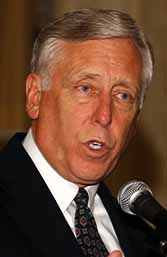
|
|
Steny Hoyer (D-MD):
another deep thinker
|
Gul addressed Steny Hoyer, Head of the US Congress Defense
Committee, as follows: “You too signed this resolution. Did you know that in the years
it is claimed that genocide took place, the Ottoman Foreign Minister and the London
Ambassador were Armenians? If there was a genocide, why were these people not also killed?
And they were occupying those positions. If you call this genocide, what would you call
the one in Germany? You will have to find another name for that.”
Gul made another speech in a meeting arranged by the German Marshall Fund and SETA
(Political, Economical and Social Research) stating that this year the strength of the
Turkish government will be renewed with the elections, and that the reform process will
continue.
Holdwater: If the politicians couldn't even answer when the
supposed genocide took place, that takes the cake; why, everyone knows the answer is
"1915," even though their genocide resolution stupidly states 1915-1923. The
better question for Gul would have been to ask what sort of proof the representatives
possessed. (Perhaps he did not want to risk stifling his laughter, when they gave an
answer like the AAA's Ross Vartian.)
Gul was off about the Armenian foreign minister, however; his time at that post was
1912-13, and technically not during the supposed genocide years.
Although the idea is no less the same; if Armenians were marked for extermination because
of racist hatred, as genocide propaganda tells us with the "pan-Turkism" theory,
then there is no way an Armenian could have served at such a high post only a couple of
years prior to war's outset... any more than a Jew could have served in Nazi Germany's
government in 1937. Good thing the Armenian foreign minister was not serving during the
war years, as Gabriel Nouradungian later cast his lot with the enemies of his country, as with the whole
of the traitorous Ottoman-Armenian community.
|
How
One Congressman Defended His Support
|
The following appeared in the Turkish Forum:
Dear Dincer:
Your comments regarding H.Res. 106 have been forwarded to my attention. I appreciate
the opportunity to respond.
The views expressed by you have been respectfully considered, and others have raised
such concerns in the past as well. I wish to state clearly that nothing in H.Res.
106 impugns individuals of Turkish descent living today, nor is it constructed to
adversely affect the relationship between the United States of America and Turkey.
The resolution sets forth a clear account of sources and facts leading up to its
declaration of policy asking the President to ensure that the foreign policy of the
United States appropriately reflects the documented circumstances of relevant
events. References are included for the purposes of allowing interested parties to
examine the historical documents underpinning America's longstanding determination
of the characterization of events in the early Twentieth Century.
I believe that Turkey's acknowledgement of such established history would be a
positive factor in world events - for it and others - and that it would serve to
strengthen already sturdy U.S.-Turkish relations. Passage of H.Res. 106, which I
co-sponsor, would hopefully expedite such a course of events. Having the utmost
respect for individuals of Turkish heritage and for Turkey, I have supported H.Res.
106 with the positive motive of conforming U.S. policy based on historical facts and
providing an opportunity for the international community to move beyond any
consequences from the failure of bringing the matter to a just resolution.
While I regret that we are in disagreement on this serious matter, it is hoped that
the foregoing provides to you the basis for my sponsorship, just as your letter
expressed your views to me.
Thank you for taking the time to contact me. Please feel free to do so regarding any
matter of concern to you.
Sincerely,
John F. Tierney
Member of Congress
Have we got Congressman Tierney's brilliant line of reasoning?
First, of course, an honorable investigation of the historic evidence must be deemed
as completely irrelevant, and what he embarrassingly terms as the resolution's "clear
account of sources and facts" must be accepted at face value. He then
simple-mindedly sets forth Turks today as being off the hook (try telling that to
Samantha Power, who enjoys equating
modern Turks with Nazis; anyone with half a brain is aware a primary purpose of
racist Armenian propaganda is to reinforce the "Terrible Turk"
stereotype), and that this vicious propaganda won't "adversely affect the
relationship between the" USA and Turkey. (Cue in "Twilight Zone" theme
music, here.)
And can you believe the following utter hypocrisy and stupidity? "References
are included for the purposes of allowing interested parties to examine the
historical documents." No one should be more of an interested party than
congressional representatives considering this hokum, yet quite obviously, Tierney
has unprofessionally not shown the slightest interest in seriously analyzing the
claims.
And when he finally tells us Turkey's acceptance of this genocide invention "would
be a positive factor in world events." one must shiver with disbelief.
Elected politicians ought to be vigilant against exposing their inability and/or
unwillingness to examine complex issues; otherwise, people just might lose faith in
their government, with such examples of mediocrity at the helm.
Isn't it irritating for someone as this fellow who is motivated by reasons that have
nothing to do with the truth to pretend that he is holding the moral high ground?
|
Armenian sway over US lawmakers
By Laura Smith-Spark
BBC News, Washington
(What is below has been excerpted; here is the original.
Emphasis below is Holdwater's.)
Given that Armenians represent only about 1.5m of America's 300m population, what
has won them such influence over the US Congress - and perhaps the nation's foreign
policy?
Part of the answer lies in the organisation and determination of the
Armenian-American lobby groups, says Dr Svante Cornell, of the Central Asia-Caucasus
Institute at Johns Hopkins University.
The Armenian National Committee of America (ANCA) and the Armenian Assembly of
America (AAA) are among the most powerful.
Another factor is that the Armenian-American community is largely concentrated in
important states such as California, Michigan and Massachusetts, Dr Cornell said.
"You have basically a number of places where the Armenian issue is very
important in local politics — especially for anybody wanting to get elected in
California," he said.
"The Turkish lobby is much less organised and much less rooted in an electorate
than the Armenian lobby."
|
Related:
Resolution
Evolution
The Importance of Genocide
Resolutions
The
"Genocide Resolution" in America Almost Passes
|
|